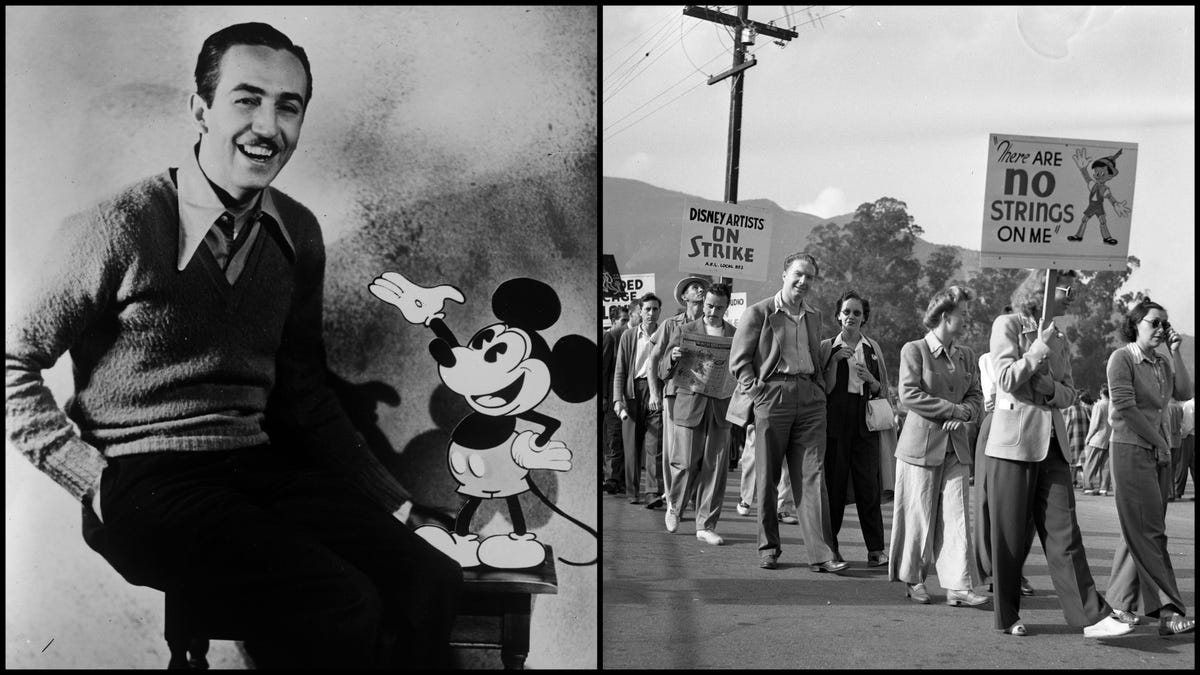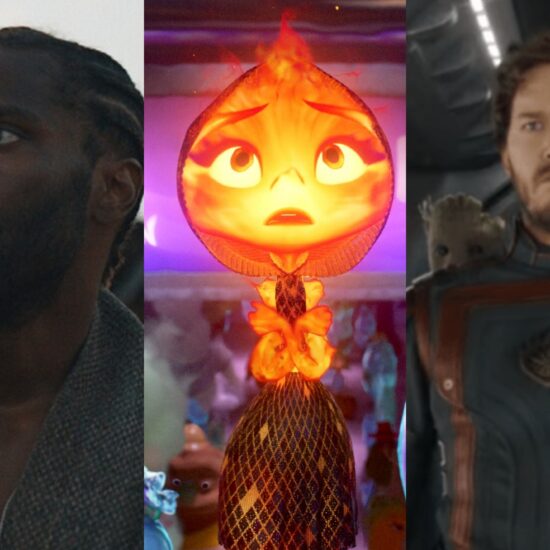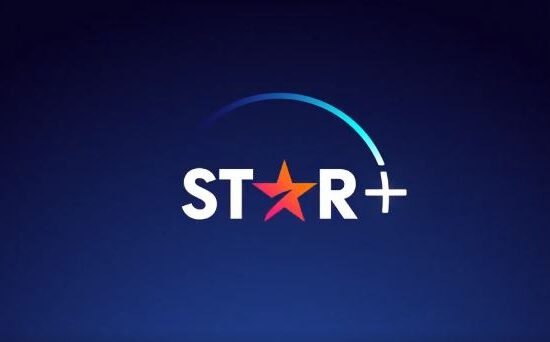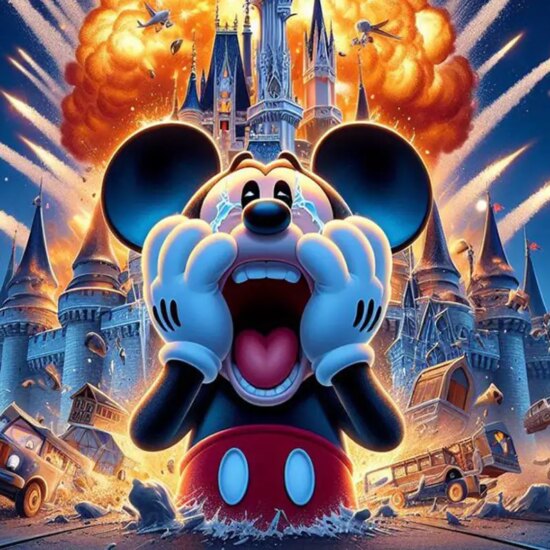
With their concurrent Hollywood strikes, the Writers Guild of America and the Screen Actors Guild have designs on transforming the entertainment industry—a decidedly hard thing to do. But there are precedents, in particular a rancorous work stoppage that almost destroyed the Walt Disney Company at a moment when it’s “golden era” had barely begun, and opened the door for an expanded presence by labor unions in Hollywood.
Ironically, the 1941 strike’s roots can be traced to the success of Disney’s blockbuster Snow White And The Seven Dwarfs, a musical fairytale released in 1937 that was the culmination of a years-long strategy to train up a workforce capable of a lusher approach to animation than the form had previously known. To make their first feature, Disney animators worked long hours without an increase in pay. But they were promised bonuses (previously awarded at 20 percent of profits on Disney shorts) if Snow White succeeded. When the dust cleared, Disney’s breakthrough smash stood as the highest-grossing sound movie ever made.
It was a shared accomplishment, but the spoils belonged to Walt Disney and his brother and business partner Roy. The proffered bonuses disappeared, supplanted by a new Disney dream: to build a Burbank animation campus capable of generating one or more animated features per year. With the new backlot came a caste system. Lead writers, animators, and studio execs got spacious offices, an executive lunchroom, even a steam room and gym. Rank-and-file animators stayed, en masse, within the rooms designated to their departments, seated at drawing boards in communal spaces, where the higher ups could check their progress.
Disney might have ridden all this out, but the shadow of World War II was falling on Europe. Slowly, war and occupation blocked foreign markets—particularly damaging to Disney, whose animated films could succeed anywhere, as long as they were redubbed. Then the Snow White follow-ups Pinocchio and Fantasia flopped badly upon initial release, Disney’s profits sank further, and the company leveraged itself to the eyeballs. When he started lay-offs, Walt had already consumed his staff’s goodwill.
The Mouse House has no use for unions
It didn’t help that one of Disney’s leading creative forces felt he’d been hoodwinked into stifling worker unrest for years. Art Babbitt was the guiding light behind Disney superstar Goofy, and he served as a directing animator on both Pinocchio and Dumbo. Other animators loved him. So when Disney attorney Gunther Lessing wanted to install a company “union” as a way of forestalling the real unionization efforts sweeping Hollywood, he enlisted Babbitt to sign up staff.
Soon the deceptively named “Federation of Screen Cartoonists” became the counterfeit “union” at the House of Mouse. When Federation reps attempted to open contract negotiations in 1939, they were ignored by Disney CEO Roy O. Disney, who allegedly said “[he] had no use for unions.” In response, Babbitt and the Federation’s negotiating committee suspended operations.
Less than two years later, real labor unrest came to Disney amidst a changed landscape. The Screen Cartoonists Guild had just successfully unionized the Popeye cartoonists at Fleischer Studios and the Tom And Jerry team at MGM, and it began signing up Disney artists, one by one.
In late 1940, the SCG notified Walt that it represented most of his staff, and wanted to meet for contract negotiations. Walt summoned Babbitt and the old Federation negotiating committee to ask them to help him block the SCG. Babbitt’s response was to join and ultimately chair the Disney chapter of the Screen Cartoonists Guild.
A mass firing took place in May 1941, with Disney tossing out two dozen members of the SCG. Then on May 27, Disney fired Art Babbitt. That same night, the Disney chapter of the SCG voted to strike. Over 300 Disney staff members began picketing Uncle Walt’s new dream studio, around the clock.
Ominously, Walt began casting his labor worries in terms of “un-Americanism”—as a battle for the soul of the country itself. But his anti-American gambit didn’t work. The strike ended when the National Labor Relations Board found in favor of the strikers—a complete victory for the Babbitt faction on the lot. Wages would increase by 23 percent, to the highest in animation, and each striker would be awarded $100 from Disney, effectively making him the subsidizer of his own strike.
Uncle Walt gets his revenge
Six years later, Walt eagerly appeared before the House Un-American Activities Committee on Capitol Hill in Washington D.C. He claimed the bitter animators strike was a byproduct of communist agitation, but the truth was more complex, and Walt, who had been deeply engaged in his studio’s anti-union battles, had to know this.
It’s probable he was tempted to name Art Babbitt. Instead, he charged union leader Herb Sorrell with communist ties, along with two ex-Disney employees: William Pomerance, a business manager; and David Hilberman, who animated dwarfs in Snow White before leaving to co-found the renegade modernist animation house UPA. Once Disney denounced him, Hilberman’s career was dogged by charges of communist sympathies. His pioneering animation venture Tempo Productions went out of business virtually overnight after being targeted by the red-baiting newsletter Counterattack. In subsequent years, Hilberman relied on UPA collaborators and Art Babbitt for project work.
Walt was forced to rehire Babbitt with back pay, after years of litigation, in a case that went all the way to the Supreme Court. Understandably perhaps, the two men never reconciled. But 66 years after the Disney animators went out, Walt’s nephew Roy inducted Babbitt into the corporate pantheon by naming him a “Disney Legend.” In addition to the Fantasia-themed trophy accepted by his widow Barbara Perry (who was escorted to the stage by Goofy), a plaque with Babbitt’s name on it was installed on the Disney lot.
It’s there still, gleaming in dream factory sunshine, poised somewhere between the site of the picket line Babbitt once walked, and the hallways he and Walt Disney used to share.














